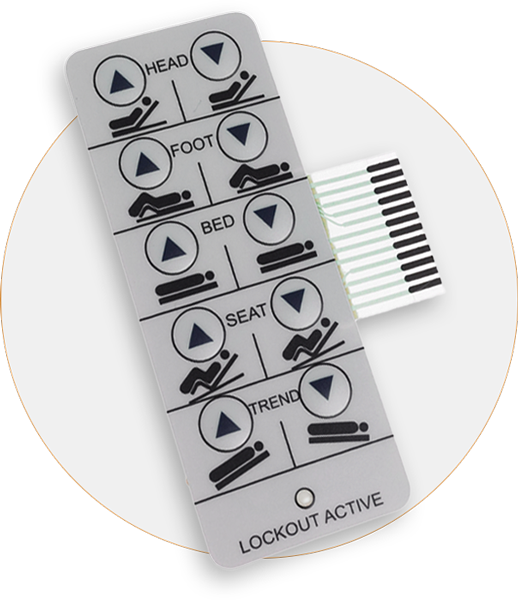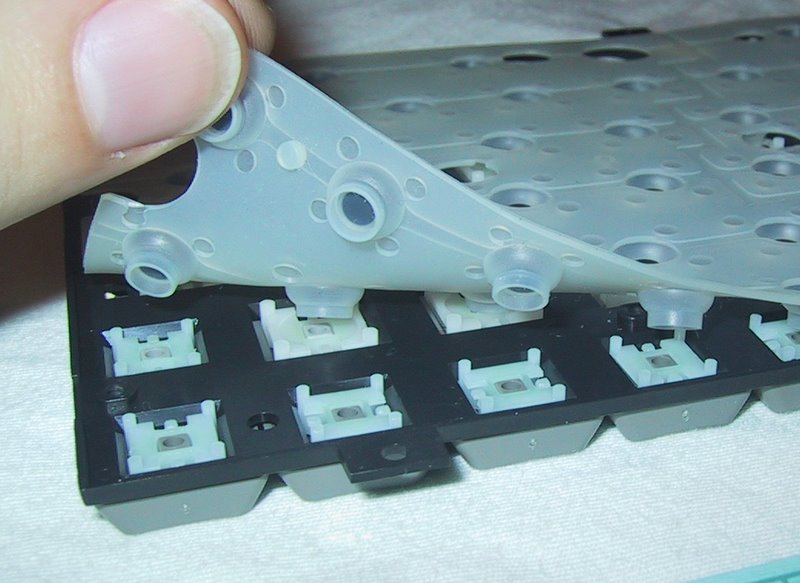All About Membrane Layer Switch: Recognizing Its Design and Capability
When you believe concerning the control interfaces in modern-day devices, membrane layer buttons typically come to mind. Allow's explore what sets membrane layer switches apart from other control systems.
What Are Membrane Buttons?

Membrane buttons can likewise be customized pertaining to form, dimension, and graphics, allowing suppliers to develop special user interfaces customized to particular items. Generally, membrane layer buttons play a significant function in boosting user experience throughout a wide range of applications.
How Membrane Changes Work
When you push a key on a membrane button, it triggers a straightforward yet effective mechanism. membrane switch manufacturer. The top layer, usually made of versatile product, pushes down onto a conductive layer below it.
You'll notice that the responsive responses varies based on the button style, offering either a soft click or a much more obvious response. Once you launch the secret, the membrane go back to its initial placement, resuming the circuit and quiting the signal. This procedure happens virtually instantaneously, making sure a responsive user experience.
Membrane layer buttons are popular because of their longevity and resistance to dirt and moisture, making them excellent for various applications, from household appliances to medical tools. Comprehending this operation assists you value their extensive use.
Secret Components of Membrane Switches
Understanding the vital components of membrane layer buttons is fundamental for grasping their performance and layout. At the core, you'll locate the graphic overlay, which supplies the aesthetic interface for customers. Underneath that, there's a spacer layer that divides the circuit layers, making certain that they do not make contact until pushed. The circuit layer is where the magic happens; it consists of conductive traces that finish the circuit when you push the button. An additional vital aspect is the sticky backing, enabling the switch to stick to surfaces securely. The protective layer guards versus ecological variables and wear, prolonging the button's life expectancy. Each component plays a significant role in ensuring trusted efficiency and individual interaction. By understanding these parts, you'll gain understanding right into how membrane layer changes operate and their significance in numerous applications.
Materials Utilized in Membrane Switch Over Design
The efficiency and toughness of membrane changes greatly rely on the materials made use of in their design. You normally come across polyester and polycarbonate as primary substrates due to their exceptional toughness and versatility. These materials stand up to scrapes and chemicals, making them ideal for requiring environments.
The conductive layers usually use silver or carbon, selected for their dependability and conductivity. membrane switch manufacturer. Silver offers premium performance, while carbon is a cost-efficient alternative. For the overlay, you may consider a matte or shiny finish, depending on your aesthetic requirements and customer experience
Adhesives play a vital duty as well; they bond layers securely and guarantee longevity. Ensure to pick adhesives that hold up against ecological factors like temperature and moisture. Ultimately, don't forget the importance of a great printing strategy for graphics, as it improves both functionality and aesthetic allure. Selecting the appropriate materials will certainly assure your membrane layer button stands the examination of time.
Style Considerations for Membrane Layer Switches
While creating membrane switches, it's essential to take into consideration various variables that affect their capability and individual experience. Begin by concentrating on the format and switch dimension; make sure they're instinctive and simple to browse. Take into consideration the tactile responses you want to supply-- will individuals require a recognizable click or a softer touch? Furthermore, think of the products you'll utilize, as they'll influence resilience and appearances.
Don't ignore the graphic style; clear labeling and shade contrast are considerable for visibility. Confirm your style suits ecological factors, like dampness or temperature variations, which might affect performance. Finally, remember the significance of screening models with genuine customers to gather feedback and make needed modifications. This repetitive process assists you fine-tune the layout, confirming it satisfies both useful and aesthetic demands properly. By meticulously considering these aspects, you'll produce a membrane layer button that improves usability and satisfaction.
Applications of Membrane Buttons
Membrane layer buttons are flexible components found in various applications, from industrial tools to consumer electronics. You'll see their effect in devices that need sturdy user interfaces and in tools that gain from sleek designs. Comprehending these applications aids you appreciate the performance and usefulness of membrane buttons in daily technology.
Industrial Tools Usage
When you're looking to enhance the functionality of industrial devices, membrane buttons provide a reliable solution that incorporates resilience with easy to use design. These buttons are excellent for harsh environments, giving resistance to dust, wetness, and chemicals. Embrace membrane layer buttons best site to improve your operations and enhance general performance.
Customer Electronic Devices Combination
In the domain name of customer electronic devices, membrane layer buttons play an important role in enhancing user interaction and device functionality. You'll locate them in gadgets like microwaves, remote controls, and gaming consoles, providing a seamless way to connect with modern technology. Their sleek style enables easy integration into various items, making controls user-friendly and straightforward. With their capacity to include graphics and backlighting, you can delight in a modern visual that enhances the gadget's general look. Membrane switches additionally assure durability and resistance to dust and wetness, expanding the lifespan of your electronic devices. By picking membrane layer switches, you improve not simply the performance but also the design of your devices, making day-to-day communications smooth and enjoyable.
Benefits and Disadvantages of Membrane Layer Switches
While membrane layer buttons use a range of benefits, they likewise come with some disadvantages that you should think about. One substantial advantage is their small layout, making them suitable for space-constrained applications. They're additionally cost-efficient, offering a resilient solution with a low production expense. Furthermore, their seamless surface is easy to clean, improving hygiene in atmospheres like hospitals.

Membrane buttons can have a shorter life-span compared to mechanical buttons, particularly under heavy use. They can also be much less responsive, which may affect individual responses throughout operation. Balancing these pros and disadvantages index will certainly help you establish if membrane layer switches are the best fit for your job.
Frequently Asked Inquiries
How Much Time Do Membrane Switches Over Commonly Last?
Membrane changes commonly last in between 5 to one decade, relying on usage and ecological conditions. You'll intend to review factors like wear, direct exposure to moisture, and temperature variations to evaluate their longevity effectively.
Can Membrane Layer Switches Be Customized for Details Styles?
Yes, you can customize membrane layer buttons to fit particular styles (membrane switch manufacturer). You'll have the freedom to select shades, shapes, and layouts that match your job's demands, guaranteeing they blend flawlessly with your general visual
What Is the Expense Range for Membrane Layer Switch Production?
The expense array for membrane switch production commonly drops between $1 and $10 each, relying on factors like style intricacy, quantity, and materials. You can obtain quotes from manufacturers to discover the ideal choice.

Are Membrane Switches Over Water-proof or Immune?
Membrane switches can be developed to be water resistant or immune, depending on materials used and building and construction methods. This Site If you need them for damp settings, ensure you define those needs during the style procedure.
How Do Membrane Changes Contrast to Typical Switches?
Membrane layer buttons are normally thinner and more flexible than conventional buttons, supplying a smooth layout. They're often simpler to clean up and integrate, but could not supply the responsive responses you're used to with mechanical choices.
Verdict
